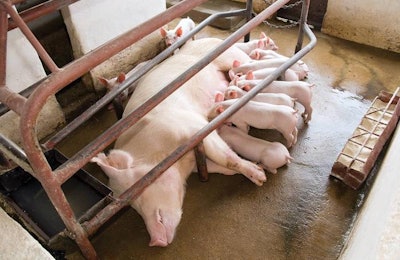
This article appears in the July/August issue of Pig International. View all of the articles in the digital edition of this magazine.
Even though creep feeding is an old theme, I am quite often asked (especially when producers switch weaning age) whether it pays off. Simply put, it does! But there are certain conditions that must be met for this feed management tool to work properly. Here are three pointers to make creep feeding work.
1. Creep feeding and weaning age
The first such condition is the weaning age of the piglets. For piglets to fully benefit from creep feeding, they must have sufficient time to consume about 500 grams of feed before weaning. When pigs are weaned at 15-18 days of age, creep feed intake is rarely over 100 grams per pig. Thus, the only benefit that can be claimed is that pigs at least realize pellets or dry meal as a form of nourishment. But there is one big problem following such limited and early exposure to dry feed, in that the gastrointestinal system might be prematurely triggered to a delayed hypersensitivity reaction if the feed contains any source of soybeans. This usually manifests itself in the form of profuse diarrhea after weaning when pigs start consuming larger quantities of feed while any protective effect of mother’s milk is removed. Thus, for very early-weaned pigs, it is best not to offer any creep feed at all. In contrast, when weaning weights must be boosted, it is strongly advised to offer them a milk replacer.
In contrast, when pigs are weaned at approximately 25 days of age, creep feed intake approaches the limit of 500 grams of pigs, bypassing the danger of delayed hypersensitivity reaction. In this case, pigs not only become rapidly accustomed to consuming dry feed, but they are also weaned markedly heavier. Based on research and experience, it can be said that creep feeding can be associated with as much as an extra kilogram body weight as weaning age approaches 28 days of age. Therefore, with later weaning ages, as currently practiced throughout Europe, creep feeding must be a common feature in all piglet feeding programs.
When pigs are weaned at 35 days of age, creep feeding is so successful that it is often advisable to discontinue offering the initial feed after one week and replace it with a less dense/complex diet to prevent pigs from scouring from overfeeding.
2. Buy the best, switch fast
Once the question to creep-feed or not has been answered, the next decision that must be made regards the type of feed to use. Clearly, all kinds of feed are not suitable for the highly immature digestive system of a newborn piglet. Without doubt, whole-milk pellets would be most preferable, but pigs are raised for profit, and thus a compromise must be made. To this end, the soundest advice is to buy the best feed you can find with the available money. It is beyond doubt that a high-quality, complex creep feed that matches the milk-oriented digestive system of piglets should be the best candidate for a successful outcome. Such feeds are usually produced by specialist companies with long experience in tracing, mixing and pelleting high-quality ingredients into complete feeds, usually pelleted, that contain high levels of cooked cereals, milk proteins and lactose, fish meal and animal plasma (where permitted), and low levels of soybean meal or other ingredients rich in antinutritional factors.
No doubt, such diets are expensive, but considering the relatively low consumption (~500 g/piglet) usually achieved under the best conditions with the best available formula, such an expense does not seem totally inappropriate when one considers the tremendous benefits of creep feeding (that is, when done properly). In my opinion, it is best to "invest" in the best possible creep feed to offer the first few days, followed up by a more conventional diet (for example the first post-weaning diet), until weaning. This method ensures pigs get the best possible start on dry feed, without overspending.
3. Management is key
Now, the next logical question is "How is it done?" The secret, if there is such a thing, is in the old but wise advice of little and often. Yes, it is labor intensive, and yes, it is not fun after the first few times, but pigs are biological organisms and that’s the way they work. Given spoiled or stale feed they simply refuse to eat it, or even explore it, as long as they have access to mother’s warm milk. Hardly possible to blame them!
So, start with a small quantity of fresh creep feed (~50 g) from a newly-opened bag and offer it on an open plate or spread it on their sleeping mat. Preferably do so between sow feeding times because pigs know they are going to get a good milk meal right after the sow eats. Next time around the farrowing barn, clean up any leftovers and replenish with another portion of creep feed, even though some litters did not consume their share. To this end, it’s best for the creep feed to be kept outside the farrowing barn so that it does not pick up the smells pigs are used to. I cannot say with confidence that an aroma added to creep feeds helps, but it certainly does not harm the process, especially if feed must remain in open feeding carts between feedings.
Once piglets consume their allotted portion, it is probably a good time to switch to a less expensive product, or even wean them. And, one final remark: Pigs eating creep feed must also drink fresh water. So, make sure they have access to it all the time and that they know how to use the drinking devices.

















